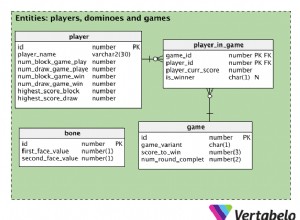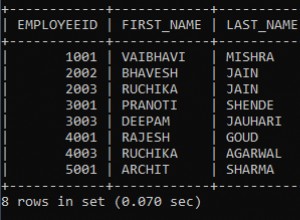Przy wielu okazjach robiłem coś podobnego. Zasadniczo grupowanie oparte na separacji w ramach złożonego uporządkowania. Podstawy stosowanego przeze mnie podejścia do tego problemu są następujące:
- Zbuduj tabelę wszystkich interesujących przedziałów czasowych.
- Znajdź czas rozpoczęcia dla każdej grupy interesujących przedziałów czasowych.
- Znajdź czas zakończenia dla każdej grupy interesujących przedziałów czasowych.
- Dołącz czas rozpoczęcia i zakończenia do listy przedziałów czasowych i grupy.
Lub bardziej szczegółowo:(każdy z tych kroków może być częścią jednego dużego CTE, ale podzieliłem go na tabele tymczasowe, aby ułatwić czytanie...)
Krok 1:Znajdź listę wszystkich interesujących przedziałów czasowych (użyłem metody podobnej do tej, którą łączy @Brad). UWAGA:jak zauważył @Manfred Sorg, zakłada to, że w danych autobusu nie ma „brakujących sekund”. Jeśli nastąpi przerwa w sygnaturach czasowych, ten kod zinterpretuje pojedynczy zakres jako dwa (lub więcej) różne zakresy.
;with stopSeconds as (
select BusID, BusStopID, TimeStamp,
[date] = cast(datediff(dd,0,TimeStamp) as datetime),
[grp] = dateadd(ss, -row_number() over(partition by BusID order by TimeStamp), TimeStamp)
from #test
where BusStopID is not null
)
select BusID, BusStopID, date,
[sTime] = dateadd(ss,datediff(ss,date,min(TimeStamp)), 0),
[eTime] = dateadd(ss,datediff(ss,date,max(TimeStamp)), 0),
[secondsOfStop] = datediff(ss, min(TimeStamp), max(Timestamp)),
[sOrd] = row_number() over(partition by BusID, BusStopID order by datediff(ss,date,min(TimeStamp))),
[eOrd] = row_number() over(partition by BusID, BusStopID order by datediff(ss,date,max(TimeStamp)))
into #ranges
from stopSeconds
group by BusID, BusStopID, date, grp
Krok 2:Znajdź najwcześniejszy czas każdego przystanku
select this.BusID, this.BusStopID, this.sTime minSTime,
[stopOrder] = row_number() over(partition by this.BusID, this.BusStopID order by this.sTime)
into #starts
from #ranges this
left join #ranges prev on this.BusID = prev.BusID
and this.BusStopID = prev.BusStopID
and this.sOrd = prev.sOrd+1
and this.sTime between dateadd(mi,-10,prev.sTime) and dateadd(mi,10,prev.sTime)
where prev.BusID is null
Krok 3:Znajdź najpóźniejszy czas każdego przystanku
select this.BusID, this.BusStopID, this.eTime maxETime,
[stopOrder] = row_number() over(partition by this.BusID, this.BusStopID order by this.eTime)
into #ends
from #ranges this
left join #ranges next on this.BusID = next.BusID
and this.BusStopID = next.BusStopID
and this.eOrd = next.eOrd-1
and this.eTime between dateadd(mi,-10,next.eTime) and dateadd(mi,10,next.eTime)
where next.BusID is null
Krok 4:Połącz wszystko razem
select r.BusID, r.BusStopID,
[avgLengthOfStop] = avg(datediff(ss,r.sTime,r.eTime)),
[earliestStop] = min(r.sTime),
[latestDepart] = max(r.eTime)
from #starts s
join #ends e on s.BusID=e.BusID
and s.BusStopID=e.BusStopID
and s.stopOrder=e.stopOrder
join #ranges r on r.BusID=s.BusID
and r.BusStopID=s.BusStopID
and r.sTime between s.minSTime and e.maxETime
and r.eTime between s.minSTime and e.maxETime
group by r.BusID, r.BusStopID, s.stopOrder
having count(distinct r.date) > 1 --filters out the "noise"
Na koniec, aby być kompletnym, posprzątaj:
drop table #ends
drop table #starts
drop table #ranges




